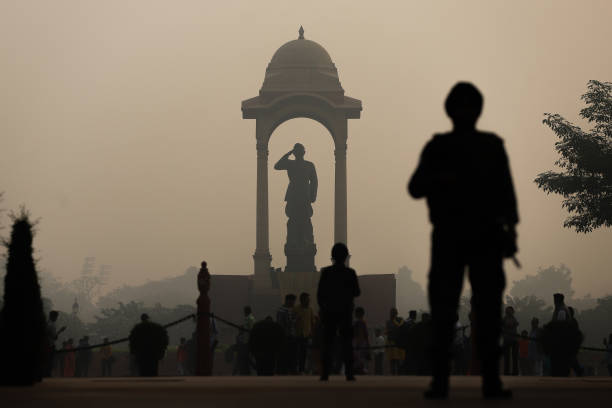
August 15, 2023
Subhas Chandra Bose and the Indian National Army: A Revolutionary Saga
Subhas Chandra Bose, a prominent figure in India's struggle for independence, remains etched in history as a charismatic leader who envisioned a free and united India. He played a important role in the formation and the leadership of the Indian National Army. The INA, also known as Azad Hind Fauj, was a significant force in the fight against British colonial rule in India during World War II. Bose's efforts and the INA's actions had a very profound impact on the course of India's freedom movement.
Early Life and Ideals:
Born on January 23, 1897, in Cuttack, Odisha, Bose was raised in a family that valued education, culture, and patriotism. Inspired by the teachings of Indian Saints, he imbibed the values of selflessness, national pride, and service from an early age. Bose's education took him to Cambridge University and later to the Indian Civil Services, but his aversion to British rule led him to resign and return to India.
Bose's Growing Dissent:
Subhas Chandra Bose's dissent against British rule grew stronger over time. He joined the Indian National Congress and became a staunch advocate of complete independence. His leadership style and dynamic ideologies marked him as a contrasting figure to Mahatma Gandhi's nonviolent approach. Bose believed in "deliverance through discipline" and was not averse to taking more aggressive measures to secure India's freedom.
Formation of the INA:
With the onset of World War II, Bose saw an opportunity to weaken British control over India. He sought help from Axis powers, Germany and Japan, to form a liberation army. In 1942, he escaped British surveillance and travelled to Germany, and with the support of the Axis powers, he raised the Indian Legion, comprising Indian prisoners of war (PoW), which later evolved into the Indian National Army (INA). He eventually reached Japan, where he collaborated with the Japanese authorities to establish the Indian National Army. The INA was mainly composed of Indian prisoners of war captured by the German and the Japanese.
Leadership and Vision:
Subhas Chandra Bose's leadership qualities were evident in his ability to inspire and mobilize people from diverse backgrounds. He coined the phrase "Jai Hind" (Victory to India) and encouraged INA soldiers to fight for the country's liberation. Bose envisioned a united India free from British rule, and his INA campaign was aimed at achieving this goal through military means. His charismatic speeches and unwavering dedication earned him the title of "Netaji" among his followers.
INA's Role and Legacy:
The INA's significance lay not only in its military actions but also in its impact on India's struggle for independence. The news of INA's formation and Bose's was not less than nightmare for Britishers. The INA's campaigns were marked by military engagements alongside the Japanese against British forces in Burma (now Myanmar) and the northeast regions of India. The INA's activities sent shockwaves through the British administration in India. The INA's actions also garnered support and sympathy from Indians who were inspired by their sacrifice and determination.

The Turning Point: INA Trials and Public Outrage:
Despite facing challenges such as limited resources and military experience, the INA managed to control areas in northeastern India. Their efforts garnered support and admiration from many Indians who saw them as true patriots. However, 1945, as WW ll reached its conclusion. After Japan's defeat in World War Il several events led to the INA's decline. Bose's mysterious death in a plane crash in 1945 added organization's challenges to INA. INA officers were court- martialed in the Red Fort, Delhi by the British. This trail generated widespread public outrage. It became a turning point in India's struggle for independence. The public sentiment was overwhelmingly against the British authorities, and widespread protests erupted across the country. The outrage over the trials and the demand for the release of the INA prisoners played a crucial role in pressuring the British to reconsider India's independence.
End of British Rule and Legacy:
The INA's role in India's fight for independence was undeniable, and its impact could not be ignored. The trials and the subsequent public agitation accelerated the process of British withdrawal from India. In 1947, India finally achieved its long-awaited independence, marking the culmination of decades of struggle. Subhas Chandra Bose's legacy as a freedom fighter and his leadership of the INA continue to inspire generations of Indians. His unwavering determination, innovative strategies, and willingness to challenge the status quo left an indelible mark on India's history. The INA's efforts, under his leadership, showcased the potential of a united, determined force fighting for a just cause.
Conclusion:
Subhas Chandra Bose's role in forming and leading the Indian National Army stands as a remarkable chapter in India's quest for freedom and also solidified his status as the "true liberator" and the "true savoir" of India. National Security Adviser of India, also once had said that India would not have been partitioned if Netaji Subhas Chandra Bose was there at the time. He was the figure who not only challenged the conventional approach to achieving freedom but also breathed life into the idea that armed struggle could lead to freedom from colonial rule.
FOLLOW US FOR MORE: – www.thesupremerights.com
OUR INSTAGRAM: – @thesupremerights

